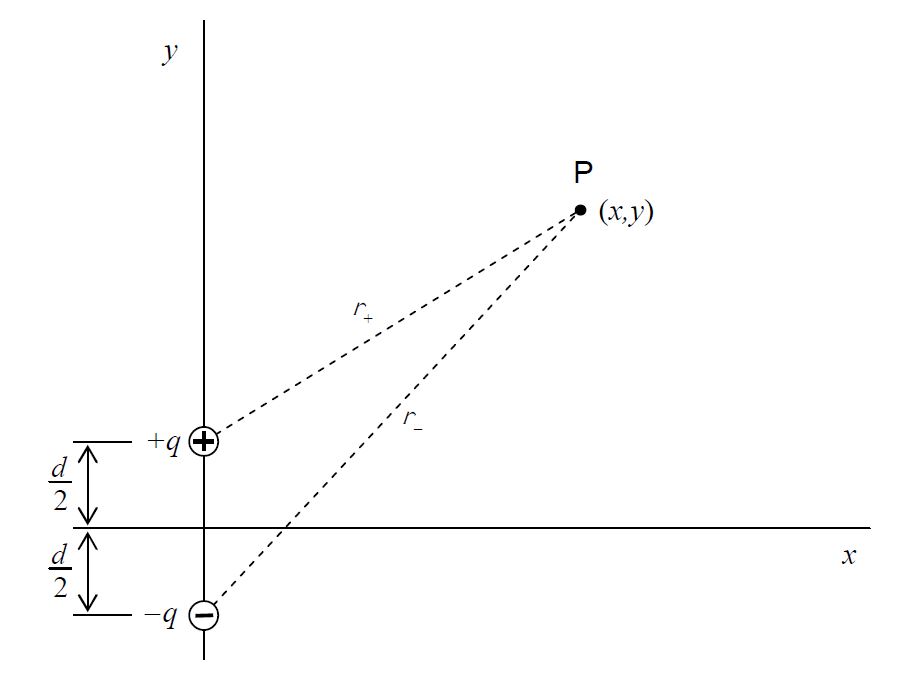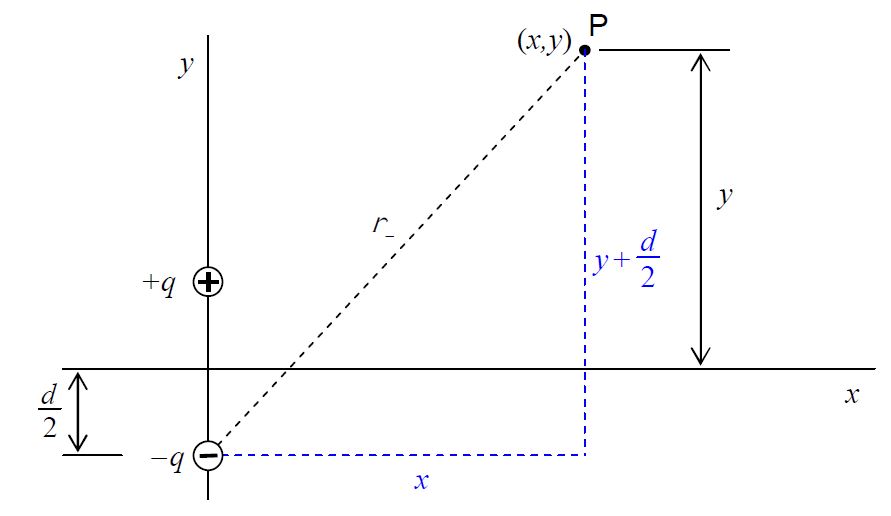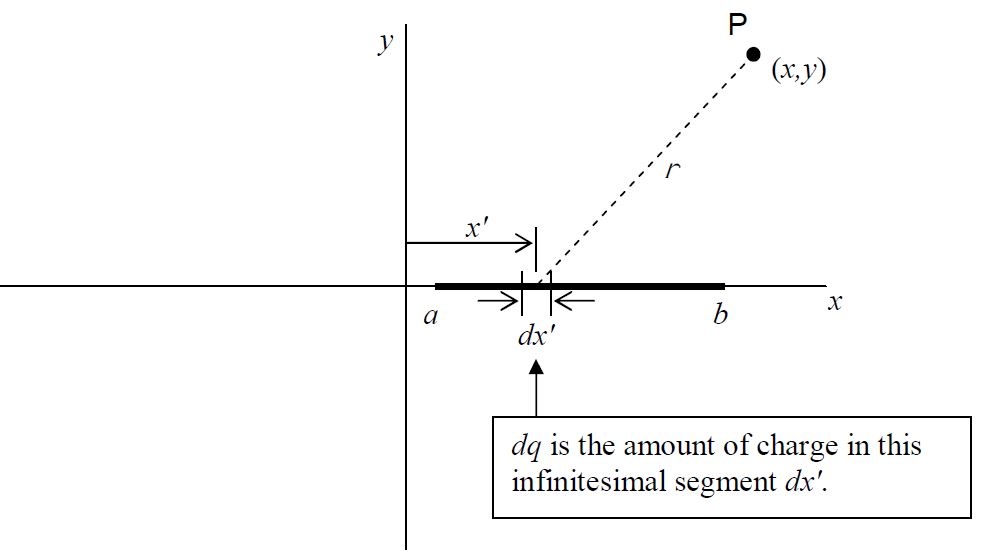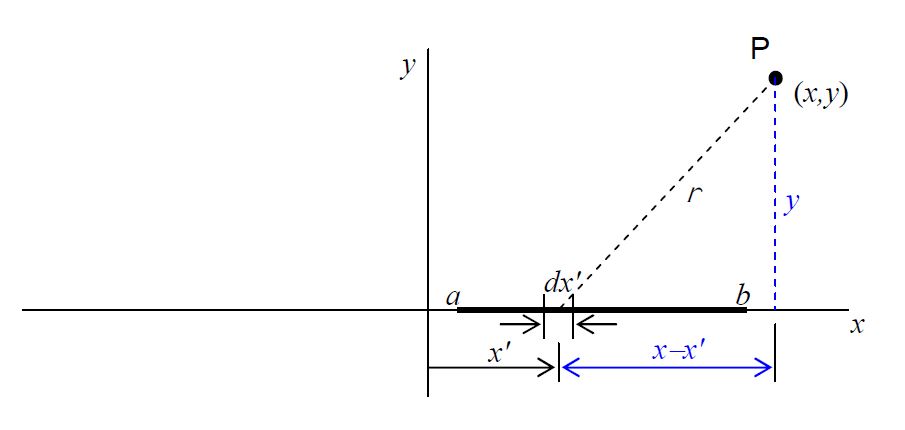Potential Due to a Continuous Charge Distribution Equation
B31: The Electric Potential due to a Continuous Charge Distribution
- Page ID
- 7921
We have defined electric potential as electric potential-energy-per-charge. Potential energy was defined as the capacity, of an object to do work, possessed by the object because of its position in space. Potential energy is one way of characterizing the effect, or the potential effect, of a force. In the case of electric potential energy, the force in question is the electrostatic force (a.k.a. the Coulomb force)—you know: the repulsive force that two like charges exert on each other, and, the attractive force that two unlike charges exert on each other. The electric potential energy of a charged particle depends on a characteristic of itself, and a characteristic of the point in space at which it finds itself. The characteristic of itself is its charge, and, the characteristic of the point in space is what this chapter is about, the electric potential-energy-per-charge, better known as the electric potential. If we can establish the electric potential-energy-per-charge for each point in space in the vicinity of some source charge, it is easy to determine what the potential energy of a victim charge would be at any such point in space. To do so, we just have to multiply the charge of the victim by the electric potential-energy-per-charge (the electric potential) applicable to the point in space at which the victim is located.
In the next chapter, we exploit the fact that if you know the electric potential throughout a region in space, you can use that knowledge to determine the electric field in that region of space.
Our purpose of this chapter, is to help you develop your ability to determine the electric potential, as a function of position, in the vicinity of a charge distribution—in particular, in the vicinity of a continuous charge distribution. (Recall that you can think of a continuous charge distribution as some charge that is smeared out over space, whereas a discrete charge distribution is a set of charged particles, with some space between nearest neighbors.)
It's important for you to be able to contrast the electric potential with the electric field. The electric potential is a scalar whereas the electric field is a vector. The electric potential is potential energy-per-charge of the would be victim whereas the electric field is a force-percharge of the would be victim. Hey, that makes this chapter easy compared to the one in which we worked on calculating the electric field due to a continuous charge distribution. It is, in general, easier to calculate a scalar than it is to calculate a vector.
Let's kick things off by doing a review problem involving a discrete distribution of charge. Please solve the following example problem and then check your work against my solution which follows the problem statement.
Find the electric potential on the \(x\)-\(y\) plane, due to a pair of charges, one of charge \(+q\) at \((0, d/2)\) and the other of charge \(–q\) at \((0, – d/2)\). Solution
We define a point \(P\) to be at some unspecified position \((x, y)\).

We call the distance from the positive charge to point \(P\), \(r_{+}\), and, we call the distance from the negative charge to point \(P\), \(r_{-}\). The electric potential due to a single point charge is given by \(\phi=\frac{kq}{r}\). Also, the contributions to the electric potential at one point in space due to more than one point charge simply add like numbers. So, we have:
\[\phi=\phi_1+\phi_2\]
\[\phi=\frac{kq}{r_{+}}+\frac{k(-q}}{r_{-}}\]
\[\phi=\frac{kq}{r_{+}}-\frac{kq}{r_{-}}\]
But, from the diagram:

we can determine that:
\[r_{+}=\sqrt{x^2+(y-\frac{d}{2})^2}\]
and from the diagram:

we can see that:
\[r_{-}=\sqrt{x^2+(y+\frac{d}{2})^2\]
Plugging both of these results into our expression \(\phi=\frac{kq}{r_{+}}-\frac{kq}{r_{-}}\) yields:
\[\phi=\frac{kq}{\sqrt{x^2+(y-\frac{d}{2})^2}}-\frac{kq}{\sqrt{x^2+(y+\frac{d}{2})^2}}\]
That's enough review. Please keep that \(\phi=\frac{kq}{r}\) formula in mind as we move on to the new stuff. Also keep in mind the fact that the various contributions to the electric potential at an empty point in space simply add (like numbers/scalars rather than like vectors).
The "new stuff" is the electric potential due to a continuous distribution of charge along a line segment. What we are dealing with is some line segment of charge. It can be anywhere, in any orientation, but for concreteness, let's consider a line segment of charge on the \(x\) axis, say from some \(x=a\) to \(x=b\) where \(a<b\). Furthermore, let's assume the linear charge density (the chargeper- length) on the line segment to be some function \(\lambda(x′)\). The idea is to treat the charge distribution as an infinite set of point charges where each point charge may have a different charge value dq depending on where (at what value of \(x′\)) it is along the line segment.

A particular infinitesimal segment of the line of charge, a length \(dx′\) of the line segment, will make a contribution
\[d\phi=\frac{kdq}{r}\]
to the electric field at point \(P\).
The amount of charge, dq, in the infinitesimal segment dx′ of the line of charge is just the chargeper-length \(\lambda(x′)\) (the linear charge density) times the length \(dx′\) of the segment. That is to say that \(dq=\lambda(x')dx'\). Substituting this into \(d\phi=\frac{kdq}{r}\) yields:
\[d\phi=\frac{k\lambda(x')dx'}{r}\]
Applying the Pythagorean theorem to the triangle in the diagram:

tells us that \(r\) can be written as \(r=\sqrt{(x-x')^2+y^2}\). Substituting this into our expression for \(dV\) yields:
\[d\phi=\frac{k\lambda(x')dx'}{\sqrt{(x-x')^2+y^2}}]
Integrating both sides yields:
\[\int d\phi=\int_a^b \frac{k\lambda(x')dx'}{\sqrt{(x-x')^2+y^2}}]
\[\phi=k\int_a^b \frac{\lambda(x')dx'}{\sqrt{(x-x')^2+y^2}}]
This is the electric potential at point \(P\) due to the charged line segment on the \(x\) axis. Each bit of charge on the line segment is specified by its position variable \(x′\). Thus, in summing the contributions to the electric potential due to each bit of charge, \(x′\) is our variable of integration. While its position coordinates have not been specified, but rather, they have been designated \(x\) and \(y\), point \(P\) is a fixed point in space. Hence, in summing up all the contributions to the electric potential at point \(P\); \(x\) and \(y\) are to be considered constants. After the integral is done, however, because we never specified values for \(x\) and \(y\), the resulting expression for \(\phi\) can be considered to be a function of \(x\) and \(y\).
Source: https://phys.libretexts.org/Bookshelves/University_Physics/Book%3A_Calculus-Based_Physics_(Schnick)/Volume_B%3A_Electricity_Magnetism_and_Optics/B31%3A_The_Electric_Potential_due_to_a_Continuous_Charge_Distribution
0 Response to "Potential Due to a Continuous Charge Distribution Equation"
Post a Comment